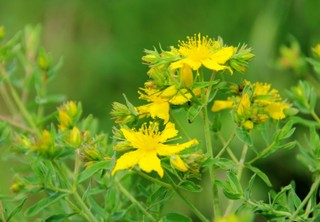How to grow St. John’s Wort indoors

Also known as goat weed, Klamath weed, and Tipton’s weed, St. John’s wort is a well-known perennial wildflower grown for its alleged health benefits. These medicinal plants are highly invasive, which makes them well-suited to growing inside your house in pots.
St. John’s Wort grows well indoors in either terra cotta or plastic containers when it receives more than 8 hours of full sun daily. Keep the soil moist and temperatures between 65 and 70℉. After the plant flowers, harvest the leaves and flowers to use as an herbal tea, oil, tincture, or poultice.

Supplies needed for growing St. John’s Wort indoors
With only a few basic supplies, it’s easy to start growing St. John’s Wort plants indoors.
Containers{: target=“_blank” rel=“noopener”}: Opt for either terra cotta or plastic pots for your St. John’s Wort plants, making sure the container walls are sturdy, and there are drainage holes in the bottom for excess water to run freely out of the container. An 8 to 10-inch pot is suitable for a single plant; a 12-inch container can hold three plants.
Growing Media{: target=“_blank” rel=“noopener”}: Commercial potting soils or coconut coir{: target=“_blank” rel=“noopener”} are the best options for filling containers. Both are lightweight and have great water holding capacity. Potting soils are specially designed for containers and mix peat moss or coconut coir, pine bark, perlite, and vermiculite. Coconut coir comes from the brown and white fibers found on a coconut between its shell and outer coating.
Plants: St. John’s Wort is started from seeds or propagated using stem cuttings. Seeds are available for purchase online or at local garden centers.
Planting Instructions
St. John’s Wort can be started by seeding or cloned from stem cuttings if you can access healthy, established plants. Both methods are relatively simple and have distinct advantages and disadvantages. Seeds need to be purchased, increasing your expense but are slower than rooting cuttings. Cuttings have no cost, but not everyone has St. John’s Wort plants to propagate.
Steps for starting from seed
It is straightforward and easy to start St. John’s Wort seeds using these basic seed-starting instructions.
- Soak seeds for a few hours or up to overnight in warm water to hasten germination.
- Fill chosen containers almost to the top with slightly damp growing media.
- Place seeds on the top of the potting soil, gently pressing them into the growing substrate.
- Keep the container(s) in a spot where the air temperature is 70℉ or higher.
- Spritz the potting soil and seeds with water often to keep the soil moist. Avoid overwatering – it dislodges the seeds and can promote rot or mold growth.
- Thin plants when the seedlings are 2 to 3-inches tall, keeping the healthiest-looking plant in each container.
Steps for propagating using stem cuttings
To propagate by stem cuttings:
- Using sterilized, sharp scissors cut a 4-inch stem piece off the mature plant.
- Remove the plant’s leaves from the bottom half of the stem.
- Dip the freshly cut stem end into rooting hormone.
- Gently place the cutting in a container with damp potting soil.

Indoor growing conditions needed
St. John’s Wort often grows outside as a wildflower across a range of USDA hardiness zones. The plants are tolerant of poor soil, adaptable to both drought and flood conditions, and unconcerned about fertilizer applications. Their tolerance makes them well adapted to grow indoors, where conditions are more stable.
Sunlight Requirements
When grown outdoors in an herb garden, St. John’s Wort plants thrive when they receive a solid 8 hours of full sun every day. They will grow in partial shade – especially if shaded during the hottest, brightest part of the day – but their growth is reduced slightly. Indoors, they do best when grown close to a south or west-facing window that receives plenty of bright sunlight.
It is often stated St. John’s Wort doesn’t grow well indoors, and that is true if plants aren’t receiving enough sunlight. If your home doesn’t stream full fun through its windows, purchase a supplemental growing light for your indoor plants. A growing light prevents plants from getting tall and leggy from lack of sun.
Temperature Needs
St. John’s Wort is originally native to North America, Europe, and Asia and grows in temperate regions worldwide. Indoors it does best growing in temperatures between 65 and 70℉ – close to most homes’ average temperatures.
During the winter and summer, keep plants away from hot and cold drafts from leaky windows, doors that are constantly opened and closed, and register vents from the furnace or air conditioning unit. These fluctuating temperatures cause internal stress and affect plant growth.

The enthusiast's guide to herbs
We’re proud to present our new e-book, The Enthusiast’s Guide to Herbs! Learn everything you need to know about growing and caring for herbs indoors, including in-depth info cards for the 35 most commonly grown herbs.
Click the link below to find out more!
Growing Tips
- Water new plants regularly until the root systems are established, then water just enough to keep the soil moist. Plants are more drought-tolerant as they mature.
- Do not allow plants to become waterlogged. St. John’s Wort is tolerant of many conditions but does not like overly wet soil.
- The flowers do not have a sweet smell. If you find the odor offensive, keep plants away from high traffic or popular areas of the home.
- Don’t over-fertilize, especially with high nitrogen fertilizers.
- Prune plants in early spring to encourage new stems. The plant’s flowers only develop on new growth.
- Unlike other herbs, allow plants to flower before harvesting.
- Harvest regularly to keep the plant looking healthy and full.
- Always prune out any dead or diseased tissue as soon as you notice it.
- Hang cuttings upside down in a cool, dark place for 10-14 days to dry.
- Watch for problems with the Klamath beetle and anthracnose. Treat plants quickly by removing pests or diseased branches manually, then apply insecticides or fungicides.

Benefits of St. John’s Wort
St. John’s wort herb has a long, rich history in herbalism. Its use dates back to the 1st century AD; it is named after John the Baptist, the infamous Jewish itinerant preacher. The plant’s beautiful yellow flowers were traditionally harvested on St. John the Baptist’s birthday feast, June 24th, and hung on houses and stall doors to ward off evil spirits.
As traditional medicine advanced, St. John’s Wort found a place in conventional medicine as well. In many cases, it works as well as prescription medications without the same side effects. Hypericin, one of the principal active components in St. John’s Wort has been used in traditional medicine to treat nerve disorders[1] and used as an anti-depressant[2] for patients’ mental health issues. It also has clinically documented anti-inflammatory properties.[3]
Today, it is one of the most frequently bought herbal supplements in the United States. St. John’s Wort is thought to have sedating properties, helping to improve various ailments such as Seasonal Affective Disorder and PMS.
When grown in home gardens and used for herbal remedies, it is commonly used as tea, tincture, or oil. When made into a poultice, it promotes wound healing.
Conclusion
St. John’s Wort makes an excellent container plant, growing well indoors when given enough sunlight and the soil isn’t waterlogged. Growing it in a pot keeps it from taking over flowerbeds or your garden while also putting the beautiful yellow flowers at your fingertips whenever you need to use the plant homeopathically.

Join our email club—get printable info cards free!
Sign up to receive our newsletter and get access to 10 printable plant info cards from our e-book for free. Also receive:
- $4 discount code for our Guide to Herbs e-book
- Semi-weekly plant inspiration & bite-size tips and tricks
Galeotti, N., Vivoli, E., Bilia, A. R., Vincieri, F. F., & Ghelardini, C. (2010). St. John’s Wort reduces neuropathic pain through a hypericin-mediated inhibition of the protein kinase C-gamma and epsilon activity. Biochemical Pharmacology, 79(9), 1327–1336. doi.org ↩︎
Cui, Y. H., & Zheng, Y. (2016). A meta-analysis on the efficacy and safety of St John’s wort extract in depression therapy in comparison with selective serotonin reuptake inhibitors in adults. Neuropsychiatric Disease and Treatment, 12, 1715–1723. doi.org ↩︎
Tedeschi, E., Menegazzi, M., Margotto, D., Suzuki, H., Förstermann, U., & Kleinert, H. (2003). Anti-inflammatory actions of St. John’s wort: inhibition of human inducible nitric-oxide synthase expression by down-regulating signal transducer and activator of transcription-1alpha (STAT-1alpha) activation. The Journal of Pharmacology and Experimental Therapeutics, 307(1), 254–261. doi.org ↩︎
